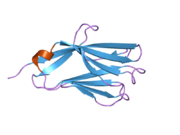CD300LF
CMRF35-like molecule 1, also known as CD300lf, is a protein that in humans is encoded by the CD300LF gene.[5][6] CD300lf belongs to the protein family of CD300. CD300lf is a membrane glycoprotein that contains an immunoglobulin domain and is expressed by myeloid and mast cells[7] of humans and other mammals. The protein functions in immunoregulation[8] but might also have a role in norovirus infections.
CD300lf and noroviruses[edit]
CD300lf has been shown to function as the primary receptor for murine norovirus in mice,[9][10] Human norovirus does not use the same receptor in viral entry.[11] Human and murine CD300lf proteins have about 59% identity in their immunoglobulin domains, with most of that variation occurring in parts of the protein called CDR3 and the CC’loop.[12] Murine norovirus binds to a cleft between these domains. The differences between murine and human CD300lf contribute to murine norovirus host species restriction, as incorporating murine CD300lf into human cells makes them susceptible to infection by the murine virus.[10]
References[edit]
- ^ a b c GRCh38: Ensembl release 89: ENSG00000186074 - Ensembl, May 2017
- ^ a b c GRCm38: Ensembl release 89: ENSMUSG00000047798 - Ensembl, May 2017
- ^ "Human PubMed Reference:". National Center for Biotechnology Information, U.S. National Library of Medicine.
- ^ "Mouse PubMed Reference:". National Center for Biotechnology Information, U.S. National Library of Medicine.
- ^ Clark HF, Gurney AL, Abaya E, Baker K, Baldwin D, Brush J, et al. (October 2003). "The secreted protein discovery initiative (SPDI), a large-scale effort to identify novel human secreted and transmembrane proteins: a bioinformatics assessment". Genome Research. 13 (10): 2265–70. doi:10.1101/gr.1293003. PMC 403697. PMID 12975309.
- ^ "Entrez Gene: CD300LF CD300 molecule-like family member f".
- ^ "CD300LF - CMRF35-like molecule 1 precursor - Homo sapiens (Human) - CD300LF gene & protein". www.uniprot.org. Retrieved 2019-03-16.
- ^ Voss OH, Tian L, Murakami Y, Coligan JE, Krzewski K (2015-10-02). "Emerging role of CD300 receptors in regulating myeloid cell efferocytosis". Molecular & Cellular Oncology. 2 (4): e964625. doi:10.4161/23723548.2014.964625. PMC 4905414. PMID 27308512.
- ^ Nelson CA, Wilen CB, Dai YN, Orchard RC, Kim AS, Stegeman RA, Hsieh LL, Smith TJ, Virgin HW, Fremont DH (September 2018). "Structural basis for murine norovirus engagement of bile acids and the CD300lf receptor". Proceedings of the National Academy of Sciences of the United States of America. 115 (39): E9201–E9210. Bibcode:2018PNAS..115E9201N. doi:10.1073/pnas.1805797115. PMC 6166816. PMID 30194229.
- ^ a b Orchard RC, Wilen CB, Doench JG, Baldridge MT, McCune BT, Lee YC, Lee S, Pruett-Miller SM, Nelson CA, Fremont DH, Virgin HW (August 2016). "Discovery of a proteinaceous cellular receptor for a norovirus". Science. 353 (6302): 933–6. Bibcode:2016Sci...353..933O. doi:10.1126/science.aaf1220. PMC 5484048. PMID 27540007.
- ^ Graziano VR, Walker FC, Kennedy EA, Wei J, Ettayebi K, Strine MS, et al. (April 2020). "CD300lf is the primary physiologic receptor of murine norovirus but not human norovirus". PLOS Pathogens. 16 (4): e1008242. doi:10.1371/journal.ppat.1008242. PMC 7162533. PMID 32251490.
- ^ Márquez JA, Galfré E, Dupeux F, Flot D, Moran O, Dimasi N (March 2007). "The crystal structure of the extracellular domain of the inhibitor receptor expressed on myeloid cells IREM-1". Journal of Molecular Biology. 367 (2): 310–8. doi:10.1016/j.jmb.2007.01.011. PMID 17275839.
Further reading[edit]
- Chung DH, Humphrey MB, Nakamura MC, Ginzinger DG, Seaman WE, Daws MR (December 2003). "CMRF-35-like molecule-1, a novel mouse myeloid receptor, can inhibit osteoclast formation". Journal of Immunology. 171 (12): 6541–8. doi:10.4049/jimmunol.171.12.6541. PMID 14662855.
- Sui L, Li N, Liu Q, Zhang W, Wan T, Wang B, Luo K, Sun H, Cao X (July 2004). "IgSF13, a novel human inhibitory receptor of the immunoglobulin superfamily, is preferentially expressed in dendritic cells and monocytes". Biochemical and Biophysical Research Communications. 319 (3): 920–8. doi:10.1016/j.bbrc.2004.05.065. PMID 15184070.
- Zhang Z, Henzel WJ (October 2004). "Signal peptide prediction based on analysis of experimentally verified cleavage sites". Protein Science. 13 (10): 2819–24. doi:10.1110/ps.04682504. PMC 2286551. PMID 15340161.
- Alvarez-Errico D, Aguilar H, Kitzig F, Brckalo T, Sayós J, López-Botet M (December 2004). "IREM-1 is a novel inhibitory receptor expressed by myeloid cells". European Journal of Immunology. 34 (12): 3690–701. doi:10.1002/eji.200425433. PMID 15549731.
- Alvarez-Errico D, Sayós J, López-Botet M (January 2007). "The IREM-1 (CD300f) inhibitory receptor associates with the p85alpha subunit of phosphoinositide 3-kinase". Journal of Immunology. 178 (2): 808–16. doi:10.4049/jimmunol.178.2.808. PMID 17202342.
External links[edit]
- Human CD300LF genome location and CD300LF gene details page in the UCSC Genome Browser.






